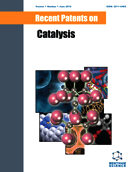Abstract
We report on a performance of the photocatalytic solar energy convertors based on mesoporous TiO2 films with immobilized enzymes and membrane pigment-protein complexes of bacterial reaction centers Rhodobacter sphaeroides and Synechocystis sp. PCC 6803 photosystem-I (PS I) using our patented immobilization technique. These semiconductor- enzymes-pigment-protein systems functioned as both the light-harvester and charge separator in photocatalytic and solar cells self-assembled on nanostructured semiconductors. We described our recent patents on different possibilities of electrons photogeneration in the TiO2 conduction band (c.b.) as well as possibilities to use the potential of e- in the TiO2 c.b for the catalytic reduction of H+ to molecular hydrogen and for reduction of NAD+ (NADP+) to NADH(NADPH) by immobilized enzymes. We also report on femtosecond dynamics of charge separation in PS I with relation to these photocatalytic solar energy convertors.
Keywords: Enzymes, hydrogen production, photosynthesis, plasmons, photocatalysis, solar energy conversion, titanium dioxide films.
 7
7

